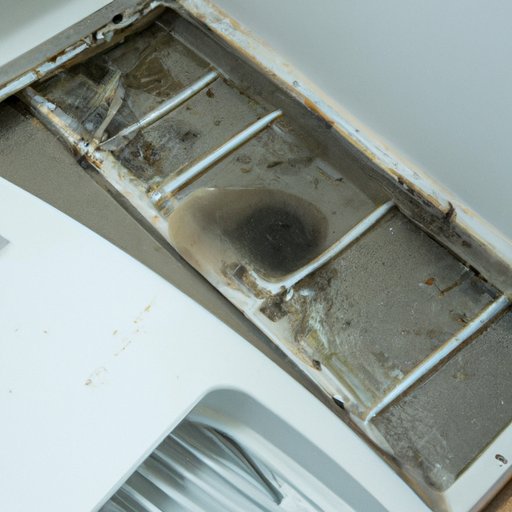Introduction
Bathroom mold is a common problem for many homeowners. This type of mold is caused by moisture build-up in the bathroom, and can cause damage to walls, floors, and other surfaces. It is important to understand the causes of bathroom mold and take steps to prevent it from growing and spreading.
Mold is a type of fungus that grows best in moist and damp environments. It is commonly found in bathrooms due to the high levels of humidity and moisture present in these areas. Mold can cause health problems such as allergies, asthma, and even skin irritation. It is also unsightly and can make your home look dirty and unkempt.
Wipe Down Surfaces Regularly
The first step in getting rid of bathroom mold is to regularly wipe down all surfaces with a damp cloth. This will help to remove any dirt and dust that has accumulated on the walls and floors, which can contribute to the growth of mold. Wiping down surfaces also helps to reduce the amount of moisture in the air, which is essential for preventing mold growth.
When wiping down surfaces, it is important to use a gentle cleaner that is specifically designed for use in bathrooms. It is also important to dry the surfaces thoroughly after cleaning to ensure that no moisture remains. This will help to prevent mold spores from taking hold and growing.
Increase Ventilation
Another important step in getting rid of bathroom mold is to increase ventilation. Poor ventilation can cause moisture to become trapped in the air, creating an environment that is ideal for mold growth. Installing an exhaust fan in the bathroom can help to reduce the amount of moisture in the air, making it less hospitable for mold.
It is also important to open windows and doors when showering or bathing to allow for fresh air to enter the bathroom. This will help to circulate the air and reduce humidity levels, making it harder for mold to grow.
Use a Dehumidifier
Using a dehumidifier in the bathroom can help to reduce the level of moisture in the air, making it difficult for mold to thrive. Dehumidifiers work by absorbing moisture from the air and collecting it in a tank, which can then be emptied and disposed of. Dehumidifiers are particularly effective in small bathrooms where there is not enough ventilation.
When using a dehumidifier, it is important to keep the device at the correct setting. The settings should be adjusted according to the size of the room and the amount of moisture present in the air.

Clean with Bleach or Vinegar
Cleaning with bleach or vinegar can also help to get rid of bathroom mold. Bleach is a powerful disinfectant that can kill mold spores on contact. Vinegar, on the other hand, is a milder alternative that is also effective at killing mold.
When using these products, it is important to wear protective gloves and clothing to avoid any potential skin irritation. It is also important to dilute the products with water before use and to avoid breathing in the fumes. After cleaning, the surfaces should be dried thoroughly to prevent further mold growth.
Use Mold-Killing Paint
Mold-killing paint is a special type of paint that contains fungicides that are designed to prevent mold growth. This type of paint can be applied directly to surfaces that are prone to mold growth, such as walls and ceilings. The paint forms an invisible barrier that prevents mold spores from settling and growing.
When using mold-killing paint, it is important to follow the manufacturer’s instructions carefully. The paint should be applied in thin coats and allowed to dry completely before adding a second coat. This will ensure that the paint is effective in preventing mold growth.
Replace Wet or Damaged Materials
If there are any wet or damaged materials in the bathroom, such as carpets or curtains, they should be replaced immediately. These materials can trap moisture and provide an ideal environment for mold growth. Replacing them with more durable and water-resistant materials can help to prevent the growth of mold.
When replacing wet or damaged materials, it is important to choose materials that are designed for use in bathrooms. These materials should be waterproof and resistant to mold and mildew growth.
Remove Moisture Sources
The final step in getting rid of bathroom mold is to remove any sources of moisture. This includes items such as potted plants, towels, and rugs. These items can all contribute to moisture build-up in the bathroom, making it easier for mold to grow.
It is also important to inspect pipes and plumbing fixtures for leaks. Leaks can cause moisture to accumulate in the walls and floor, creating an ideal environment for mold growth. If any leaks are found, they should be repaired immediately.
Conclusion
Getting rid of bathroom mold is an important step in keeping your home clean and healthy. By following the steps outlined above, you can effectively prevent mold growth and keep your bathroom looking its best. Regular wiping down of surfaces, increasing ventilation, using a dehumidifier, cleaning with bleach or vinegar, using mold-killing paint, replacing wet or damaged materials, and removing moisture sources are all effective methods of getting rid of bathroom mold.
In addition to these steps, it is also important to keep the bathroom well ventilated and maintain a consistent temperature. This will help to reduce the chances of mold growth and keep your bathroom looking its best.


